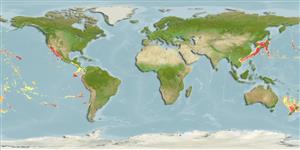Environment: milieu / climate zone / depth range / distribution range
पारिस्थितिकी
समुद्री बेनथोपिलाजिक; औशिनोड़िरोमस (Ref. 51243); गहराई सीमा 150 - 1537 m (Ref. 27311). Temperate
Northwest Pacific: central and southern Japan. Larvae found in Taiwan Strait (Ref. 43570).
आकार / वज़न / Age
Maturity: Lm ? range ? - ? cm
Max length : 90.0 cm TL पुल्लिंग / अलिंग; (Ref. 559); अधिकतम प्रकाशित वज़न: 10.2 kg (Ref. 40637)
Juveniles associate with drifting seaweed (Ref. 12114, 12115). Adults found in deeper water, at depths greater than 100 m (Ref. 559). Plankton feeder (Ref. 12115).
Life cycle and mating behavior
Maturities | पुनरुत्पत्ति | Spawnings | Egg(s) | Fecundities | लार्वा
Masuda, H. and G.R. Allen, 1993. Meeresfische der Welt - Groß-Indopazifische Region. Tetra Verlag, Herrenteich, Melle. 528 p. (Ref. 9137)
IUCN Red List Status (Ref. 130435)
Threat to humans
Harmless
Human uses
मात्स्यिकी: व्यापारिक
साधन
Special reports
Download XML
इंटरनेट स्रोत
Estimates based on models
Preferred temperature (Ref.
123201): 0.4 - 13.5, mean 7.9 °C (based on 132 cells).
Phylogenetic diversity index (Ref.
82804): PD
50 = 0.5156 [Uniqueness, from 0.5 = low to 2.0 = high].
Bayesian length-weight: a=0.01380 (0.00555 - 0.03435), b=3.06 (2.85 - 3.27), in cm total length, based on LWR estimates for this (Sub)family-body shape (Ref.
93245).
Trophic level (Ref.
69278): 3.9 ±0.63 se; based on food items.
लौटाव (Ref.
120179): निम्न, न्यूनतम जनसंख्या दुगनी होने का समय 4.5 - 14 वर्ष। (Preliminary K or Fecundity.).
Fishing Vulnerability (Ref.
59153): High vulnerability (56 of 100).
